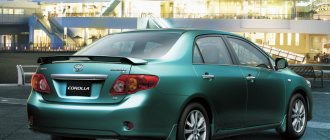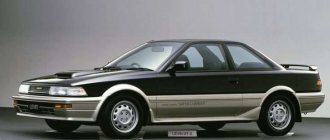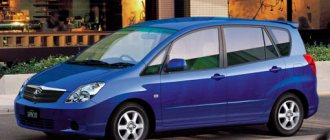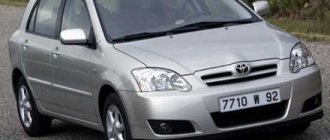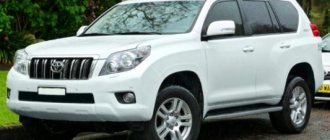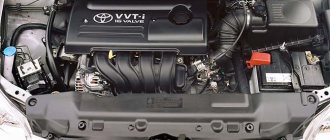The 2013 model year Toyota Corolla compact sedan was officially sold in Russia through Toyota dealerships. Cars with the new E170 body were equipped with gasoline engines designed to work with a manual or automatic transmission. The manufacturer offered a modification with a variator, which provided a smooth change in speed and was distinguished by reliability if the operating rules were observed.
Toyota Corolla 2013 is the best-selling model in Russia.
Exterior of Toyota Corolla 2013
Introduced in 2012, the new generation of Corolla cars was equipped with bodies that differed in the outline of the external panels and were intended for the North American market. The car received an elongated radiator grille with head optics units that partially extend onto the side of the wing.
The design of the car body was consistent with other models of the Japanese concern, which sought to satisfy the needs of buyers of all age categories.
Body
The monocoque 4-door body of the 11th generation Corolla was designed to carry 5 passengers. The manufacturer offered several color options; the steel panels were galvanized to increase corrosion resistance. In addition to resistance welding, laser equipment was used, which increased the strength of the structure. Corolla cars assembled at Toyota's Turkish plant were sold in the Russian Federation.
Car interior
Toyota has developed a new interior design for cars of the E170 generation, which does not have anything in common with the design of the previous version. The dial instrument cluster and control buttons received bluish-white backlighting, which improved the visibility of the indicators in the dark. The seats of the car were covered with fabric or artificial leather. Some owners note the insufficient strength of materials that tear at the seams or fray at the folds.
Toyota has developed a new interior design.
Video “Visual instructions for changing gearbox oil”
User Sanya Gontar published a video in which he described how the lubricant is replaced in Corolla CVT gearboxes.
Do you have any questions? Specialists and readers of the AUTODVIG website will help you ask a question
Was this article helpful?
Thank you for your opinion!
The article was useful. Please share the information with your friends.
Yes (92.50%)
No (7.50%)
X
Please write what is wrong and leave recommendations on the article
Cancel reply
Rate this article: ( 41 votes, average: 4.88 out of 5)
Discuss the article:
Technical specifications
When creating the car body, the developers sought to reduce drag. The aerodynamic quality coefficient was 0.28 units, which made it possible to reduce fuel costs and improve dynamics while maintaining old engines. In terms of characteristics, the Corolla E170 met the general requirements for category C sedans in 2013.
In the Russian market, it competed with Kia Cerato, Renault Fluence and Mitsubishi Lancer.
dimensions
Main dimensions of the Corolla car:
- body length - 4620 mm;
- distance between axles - 2700 mm;
- width - 1775 mm (excluding mirror housings);
- height - 1465 mm;
- turning radius - no less than 5.4 m;
- ground clearance (minimum) - 150 mm.
Volume and mass
Weight and capacity of the Corolla:
- luggage compartment volume - 452 l;
- curb weight of the vehicle - from 1225 to 1375 kg, depending on the engine;
- permissible vehicle weight - from 1735 to 1785 kg;
- passenger compartment length - 1930 mm;
- cabin width - 1485 mm;
- maximum height from floor to ceiling - 1190 mm;
- capacity - 5 people.
The vehicle capacity is 5 people.
Engine
The cars used 4-cylinder engines with a 16-valve gas distribution mechanism and the Dual VVT-i system, which made it possible to rotate the camshafts to change the phases. The basic model with a volume of 1.33 liters developed 99 liters. With. and had a torque of 128 N*m. The version with a 1.6-liter block produced 122 power and 157 N*m, and the most powerful modification had a volume increased to 1.8 liters, which made it possible to increase the power to 140 hp. With. and raise the torque bar to 173 N*m.
Gearbox and steering
Corolla cars with 1.33 and 1.6 liter engines used a synchronized 6-speed gearbox with a dry 1-disc clutch. Buyers could order cars with a continuously variable transmission, which provided smooth changes in speed. The cars had front-wheel drive. The steering is rack-and-pinion type with an electric booster located in the column and connected to the gearbox by a cardan shaft. As speed increased, the gain dropped, maintaining highway safety.
The gearbox provides smooth speed changes.
Suspension and brakes
The front wheels of the vehicle are equipped with MacPherson struts with shock absorbers of increased diameter. The upper swivel support has increased rigidity, which reduces the level of vibrations transmitted to the body. At the rear of the car, a torsion beam was used with improved mounting points for improved handling. The brake system of the machine is hydraulic, divided into 2 independent circuits.
Disc mechanisms with floating calipers are used at the front and rear.
Wheels and tires
The manufacturer used 15- and 16-inch wheels stamped from steel sheets with 195/65 and 205/55 tires, respectively. Decorative plastic caps with the Toyota logo were used. Some Corolla modifications were fitted with 16-inch aluminum alloy wheels coated with a layer of decorative varnish. The wheels of the Corolla car had a unified mounting on the hubs with 5 studs.
The manufacturer uses stamped discs.
Performance characteristics
Main operational parameters of Corolla machines:
- maximum speed - from 180 to 195 km/h depending on engine power;
- acceleration from zero to 100 km/h - from 10.2 to 12.6 seconds;
- Fuel consumption in the conventional suburban cycle is from 4.7 to 5.3 liters per 100 km;
- fuel consumption in urban conditions - from 7.2 to 8.7 liters per 100 km;
- fuel tank capacity - 55 l;
- The warranty period is 36 months or 100 thousand km.
Basic faults
Below we will look at what breakdowns are typical for Toyota Corolla variator transmissions of 2014, 2015, 2021, 2021 and other years of production and what needs to be done to repair the unit.
User Azat Ahmet encountered a problem with the noisy operation of the variator and recorded it on video.
Troubleshooting
Most transmission problems can only be detected through computer diagnostics.
Malfunctions that will lead to transmission repair:
- Broken drive belt. Over time, the V-strap begins to wear out. Its wear will be faster if the car owner does not follow operating rules and regularly drives at high speeds or off-road. Due to rapid wear, the belt breaks. Its links can fly throughout the transmission and damage other transmission components.
- Malfunctions in the operation of the control module. Usually the control unit works without interruption, but sometimes it starts to act up or fails altogether. A module failure will require its replacement. Finding a qualified CVT repair specialist today is difficult. Therefore, service station technicians usually simply change the module. The unit can be reflashed or the board can be repaired if its failure is caused by clogging or moisture. But flashing will require special equipment and software.
- Failure of support bearings. These devices are subject to high loads, especially when operating in harsh conditions or when there is a lack of lubricating fluid in the transmission. Bearings become unusable over time, and their wear products in the form of metal shavings can fall on other parts and clog the channels of the oil system. If this happens, the pressure in the system begins to increase, which can lead to its premature failure or squeezing out the seals.
- Failure of the speed controllers of the drive and driven shafts. The lubricant temperature sensor and the oil pressure in the main line or shafts are also susceptible to malfunctions. To fix the problem, you will need to dismantle the unit. Often the reason for the non-working state of sensors is damage to the contacts on their connectors or a break in the wiring. Sometimes the contacts become dirty, which causes the controller to not work correctly. It is necessary to diagnose the integrity of the connectors and “ring” the wiring. If the wires and contacts are intact, then the sensors must be replaced.
- Malfunctions in the operation of a hydraulic transformer are determined through detailed diagnostics of the device. If this unit fails, you can try to repair it by replacing the broken parts. But usually the entire device assembly must be replaced. Finding it on sale can be problematic.
- Reducing valve failure. This malfunction manifests itself in the form of jerks and jerks of the vehicle. The valve begins to operate when the power unit starts. The pumping device in Corolla CVTs is a non-separable unit. Therefore, if the valve fails, the mechanism must be replaced. During normal operation of the valve, the device moves freely along the sleeve, which is installed in the body of the pumping device. As a result of the constant interaction of the working surface of the part with various particles and deposits that are present in the oil, the valve wears out.
- If, when you try to move, the car does not move or moves, but its dynamics are too weak, it is necessary to diagnose the main clutch, as well as the CVT transmission itself. The reason may be a malfunction in the torque converter device, or less commonly, a non-working control unit.
- A malfunction of the main line pressure solenoid valve will cause the vehicle to move jerkily. And when you shift from neutral to D, you will feel a distinct jolt. The valve must be replaced.
- If you put your car in neutral and it continues to roll, there could be several reasons. First you need to check the operation of the gear shift lever, as well as the control module. The cause of the problem may be damage to the electrical circuit or connectors on the sensors. All devices must be checked.
The CorollaFielder channel has provided a video from which you can find out what a CVT transmission pan looks like after 130 thousand kilometers.
Security systems
By default, the cars were equipped with front airbags to protect the driver and front passenger and an ABS unit with support for the emergency speed reduction function. The backs and headrests of the seats were designed to reduce the risk of injury to the cervical vertebrae. Curtains and side airbags were installed on some cars, and an electronic trajectory stabilization system was used with support for the TRC function (counter-slip of the drive wheels). Starting with the Comfort version, there was an uphill start assistant, which prevented the car from rolling back.
The cars were equipped with front and side airbags.
Options and prices
The manufacturer offered the cars in 6 versions, differing in the level of equipment and type of engine. The base included plastic trim elements painted in body color. Additional turn signals were integrated into the mirror housings, and the Corolla's headlights included running lights with LED lamps designed to last the life of the vehicle. Factory recommended prices for Corolla cars as of mid-2013 are shown in the table.
| Model Corolla | Standard | Classic | Style | Comfort | Style Plus | Prestige |
| Price, thousand rubles | 669,0 | 718-755 | 749-819 | 815-852 | 819-905 | 899-945 |
Standard
The base model Corolla came only with a 1.33-liter engine with manual transmission and 195/65 tires mounted on 15-inch steel wheels. In front of the driver there was a steering wheel with a polyurethane rim and a block of buttons; there was no radio on the car. When ordering cars painted with materials with metallic or mother-of-pearl effects, an additional payment of 14 thousand rubles was required. The rule applied to all modifications of the Corolla car.
The base Corolla model has a 1.33-liter engine.
Classic
The buyer received a Toyota Corolla with a 1.6-liter engine and a manual transmission or CVT. Steel wheels with 205/55R16 tires were used, but there were few changes in the interior. The owner installed the radio himself; the main difference from the Standard was the side airbags.
Some dealers offered to install a standard sound system and aluminum wheels on Corolla cars for an additional fee.
Style
The Corolla Style version offered 1.6 and 1.8 liter engines, and the car was externally distinguished by standard front fog lights. The steering wheel had leather trim, and rear-seat passengers received electric windows. A block with 4 control keys and the ability to block the side window drives was installed on the driver's door. The factory installed a standard radio with a disc player and radio on Corolla cars, and on the version with a 1.8-liter engine, 6 speakers were used instead of the standard 4.
The Corolla Style features standard front fog lights.
Comfort
Corolla cars had alloy wheels with 205/55R16 tires and were equipped with a windshield with electrically heated brush rest area. The center armrest received a cover with fabric trim and length adjustment. An additional feature of the Corolla car is the standard 6 speakers of the sound system (regardless of the engine model) and an expanded set of security systems.
Style Plus
Corolla cars with a 1.8-liter engine in the Style Plus package received a sticker in the form of the letter S and a spoiler on the trunk lid, and chrome trim was installed on the side of the car body. Instead of manual air conditioning, 2-zone climate control was used, and there was a rear view camera with a fixed line marking. Corolla cars were equipped with a stability control system and curtain airbags that protected the driver and passengers' heads from hitting the pillars and door frames.
Corolla Style Plus cars were equipped with a stability control system.
Prestige
The top-end Corolla model was offered only with a CVT and featured electric drives for the folding rear-view mirror mechanism. The car had rain and light sensors that automatically controlled the operation of the windshield wipers and external lighting.
The Toyota Corolla multimedia center had AUX and USB connectors, and was also equipped with a Bluetooth wireless controller.
Results
For drifting and rally experiments, Toyota has other models.
One thing is required from the Corolla - reliable handling. And she guarantees it.
I have a suspicion that the Toyota Corolla has never looked so balanced. It has a wonderful design, excellent interior. At the same time, the car is controllable and economical. What else does the consumer need? Of course, I wanted the car in this configuration to cost $20,000, but there are no miracles in the world. Therefore, this particular Toyota Corolla 2013 costs $30,000.
Advantages and disadvantages
Advantages of Toyota Corolla cars noted by owners:
- beautiful appearance;
- low fuel consumption;
- fast warming up at negative air temperatures;
- reliable engines capable of running on A-92 gasoline;
- soft car suspension, smoothing out road unevenness.
Disadvantages of 2013 model year Corolla cars indicated in reviews:
- poor equipment (compared to competitors);
- insufficient sound insulation;
- a thin layer of paint and primer, damaged by branches or small stones;
- high price for original components for the car;
- Electrically heated rear seats are not provided;
- lack of standard alarm system.
Chassis and brakes
The characteristics of the Toyota Corolla 2014 suggest that it has become more maneuverable and controllable than its predecessor: this was largely possible thanks to the new settings of its suspension. And if the rear suspension is a semi-independent torsion beam, then the front suspension is an independent McPherson. The front brakes are disc, as are the rear brakes. But the first ones are ventilated, and the second ones are no longer.
Salon of Corolla E180
Additional Information
The 2013 Corolla models came standard with headlights with delayed shut-off to illuminate the way home. The rear row of seats folds in a 40:60 ratio, allowing for the transportation of long items. The dimensions of the luggage were limited by the top shelf and the plastic frame of the opening. A 5-door hatchback Auris was produced on the basis of the sedan, but the cars were not officially sold in Russia. On the roads there are individual examples of Auris, imported by owners from Europe, North America or the Middle East.
Reviews from car owners
Dmitry, 45 years old, Murmansk
I am the owner of a 2013 model year Corolla, I bought the car through an official dealer. The mileage is 160 thousand km, during operation there were no problems with the automatic transmission and engine. The engine starts without problems at an air temperature of -30°C, but the interior of the car warms up well only while driving. Several times I encountered the problem of condensate freezing in the Corolla locks. The paintwork suffers from stone impacts; there are no rust spots on the car body.
Sergey, 51 years old, Vologda
In 2021, I purchased a used Corolla car built in 2013 with an automatic transmission and a 1.6-liter engine, the mileage was 85 thousand km (confirmed by the service book). I move around the city and rarely drive on country highways. The seating position is comfortable, and the range of adjustments allows a tall person to get behind the wheel. In winter there are squeaks of plastic, but as it warms up the extraneous noise disappears. I consider the disadvantage of the car to be the high cost of original spare parts, and cheap analogues do not differ in workmanship.
Conclusion
In addition, the increased attractiveness of the Toyota Corolla in the eyes of Russian car enthusiasts lies not only in its prestige. But it also has indicative consumer characteristics, which predictably comes down to the rather high price of new cars.
But among the disadvantages of the “Japanese” it is worth noting the relatively short service interval, as well as quite expensive maintenance. Also, one should not forget that now Toyota engines are no longer as omnivorous as before, and their maintenance is much more strict.
Black Corolla 180
Toyota Corolla 2015 offers top-level performance, optimal reliability and unsurpassed safety. Not to mention the efficiency, highly ergonomic interior and incredible purely Japanese “survivability” of this car.
So if you want a reliable car for daily use, the Toyota Corolla is exactly what you need!

